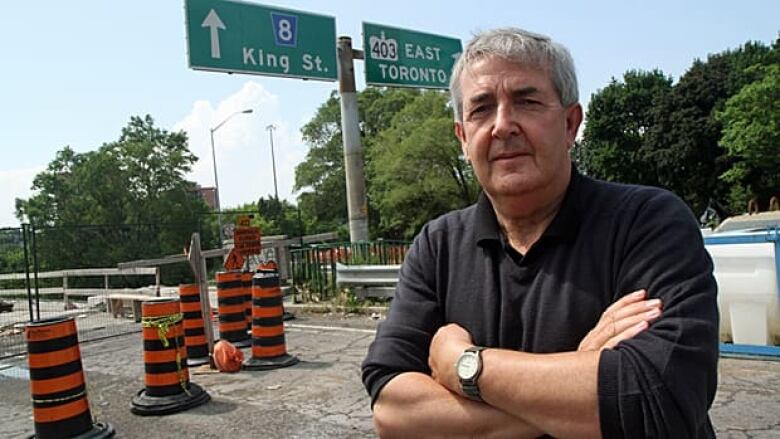Stay off Hamilton's highways during heat and smog

On days like this one, when temperatures are high and air quality is expected to worsen throughout the day, the worst place to be is on a highway.
This is according to local physicist Denis Corr, who has spent the last five years measuring air quality in specific Hamilton neighbourhoods to determine which ones pose the greatest risk to human health.
Temperatures are expected to reach 34 C today. The Ministry of Environment has issued a smog advisory. In those conditions, the worst place in Hamilton to beis Highway 403 or the QEW, where toxic particles emitted by vehicles are a risk to human health, he said.
"The highest levels of nitric oxide I've measured in the city are not from industry," he said. "They're not from the northeast part of Hamilton. It's on the highways."
For five years, Corr has used a mobile air-monitoring unit to measure air quality throughout the city. He measured 10 neighbourhoods, from Dundas to Eastport Drive.
He found that the risk of dying from air pollution in a Hamilton neighbourhood ranged from 2.5 to 7.7 per cent greater than the average mortality rate. But on highways and arterial roads, that increased to 12 per cent.
Highways cause deaths, but people aren't usually diagnosed as dying from air pollution, he said. Often, they die from heart attack or stroke, sometimes while driving.
Eighty per cent of people who die from bad air quality areaged 65 and over who are "overage, overweight and over confident," Corr said.
"If there's one big message I'd like to get out, it's before you go on the highway, put the ventilation system in your car on recirculate," he said. "Save yourself a heart attack and don't become a statistic."
Here's what he recommends:
- Put the ventilation system in your car on recirculate when you're driving on a highway. This is especially true during a smog day.
- Don't jog within 400 metres of a highway. Stay in neighbourhoodswith lots oftrees. "Trees are amazing," he said. "They're the greatest air cleaners ever."
- Lobby your politicians to make sure that air pollution is a priority. Encourage them to support transportation alternatives to cars on highways.
The negative impacts of highways last for about 400 metres off the highway, Corr said. This impact is diminished when there are sound barriers.
There is a smog advisory for today. Ontario'sAir Quality Indexforecasts moderate air quality for Hamilton this week.
The City of Hamilton has also issued a heat warning for Hamilton for Wednesday.
If the Humidex reading is at 40 or greater for more than three days, the Medical Officer of Health will issue a stage three heat alert.
We are currently at stage two.
The city is offering "cool places" for the public. They can be identified by a "Cool Down Here" sign at entrances, along with a heat metre sign that indicates the stage of the current heat alert.
The city's outdoor pools may also have extended hours.
Here's what the city recommends:
- Drink plenty of water and avoid alcohol and caffeinated beverages.
- Go to an air-conditioned place to cool off.
- Dress for the heat with loose-fitting, light-coloured clothes.
- Limit physical activity.
- Never leave children or pets in closed vehicles.
Signs of heat exhaustion include heavy sweating, weakness, cold, pale and clammy skin, weak pulse, fainting and vomiting.












_(720p).jpg)


 OFFICIAL HD MUSIC VIDEO.jpg)
.jpg)



























































































